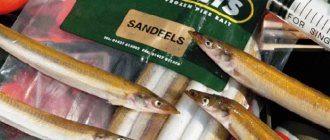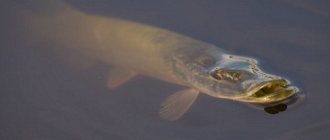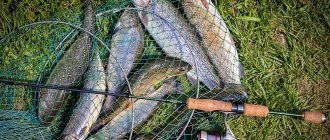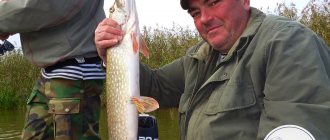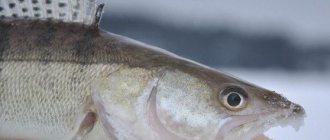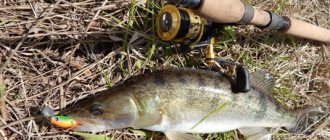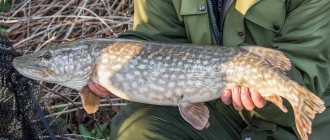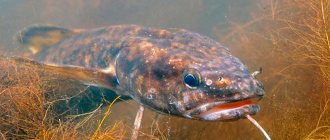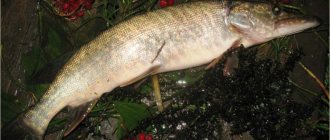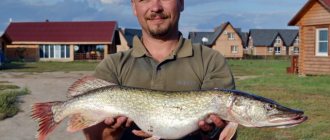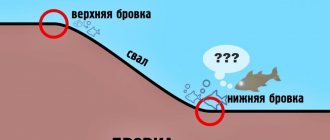Fishing from a boat on many small artificial reservoirs does not make much sense due to their small size. Therefore, it is better to practice coastal spinning fishing here. And while the new season has not gained its momentum, so to speak, you can be content with short forays into small reservoirs, quarries, ponds, etc. Moreover, without the hassle of assembling and disassembling the boat in one trip, it is often possible to visit several such bodies of water. Spinning fishing on them may not be as varied as on rivers, but it is often also quite rewarding and unexpected.
Spinning fishing in reservoirs
I still usually leave reservoirs for the boat, believing that only from a watercraft can one get to promising places. However, there are areas on reservoirs where the predator often stays within reach of shore casting. Sometimes you don’t even need to send the bait far, just throw the riverbed across - and you can make a high-quality step-by-step jig. We are talking about the lower reaches of reservoirs - areas near outlet locks and dams.
As a rule, the coast here is dammed, so it is easily passable. The depth of the dams is also quite good, which is what predators take advantage of. Usually in such places I rely more on perch - it just so happens that this is what I managed to catch en masse near various hydraulic structures. However, there were fishing trips that made it clear that there was a place for pike here too.
For example, on one of my first spinning fishing trips last year, I was so impatient to cast the bait faster that I did it right from the dam right next to the car. After casting, the bait flew over the riverbed, passed perpendicular to it and climbed out into the shallow coastal waters. This kind of relief wiring was normal, although not very long.
And what do you think: on the 4th cast I feel a weak blow on the pause at the very bottom - and a small pike on the shore. The next two casts brought approximately the same pikes - the 5th and 6th, respectively. Only the nature of the bites was different: one exactly repeated the first one by nodding the tip of the spinning rod, when the bait just began to slide into the riverbed, the other happened according to the classics - a high-quality strike on a pause, already on the way up the slope. This is the beginning!
By that time the guys had only just managed to uncover their spinning rods. However, further fishing of the area near the dam did not bring any bites, and we went to explore the reservoir upstream. it works without problems. And it’s better to do this with a jig - then you can get a good feel for the relief and understand how the riverbed runs. If the reservoir is wide and the coastal area is quite shallow, other baits come into play. In such places, with a maximum depth of usually one and a half to two meters, I prefer to twitch. Of course, not every wobbler flies as far as we would like, and therefore here you become quite demanding of wobblers.
I would call the Duo Moab F wobbler one of the most volatile in my coastal collection, preferably in size 120, but I also use 85. I somehow caught the first one on the first cast with a pike at 3700 g, since then I believe in it and keep it as "super intelligence officer" Another favorite representative of the twitching trend is the Lucky John Jerky Minnow wobbler. It was produced in only one size - 10 cm. The ball system installed in it also allows you to make long-distance and accurate casts. Perhaps this is the most noisy wobbler in my collection. The depth of the wiring is up to 1–1.2 m. I like to lead wobblers with a “rattle” not only with classic twitching, but also with uniform wiring with pauses.
There are suspicions that the noise of rolling balls when the wobbler stops also attracts pike. Under the Lucky John brand I also have, perhaps, the fastest pop-up wobbler - X? Twitch. It comes in three sizes - 7, 9 and 11 cm, but I often use the last two - larger ones. The X?Twitch wobbler pops up so quickly that I move it without pauses, but with constant twitching of the tip of the spinning rod while rotating the reel evenly.
When retrieving slowly, the wobbler allows you to move close to the surface, which is often also necessary. Finishing the topic of long-range wobblers, I must say about the longest-firing wobbler I have ever encountered. This is the Salmo Slider 7 - a mini version of the legendary jerkbait. Both the floating and sinking versions easily “break through” the wind, and can fly 70–80 meters along it.
These are also representatives of the “shallow-water fraction” of wobblers, which successfully allow fishing the coastal zone of reservoirs. I often lead the floating version of the Salmo Slider 7 wobbler evenly, with constant frequent and small jerks; I periodically offer pauses for the sinking version. Osko has models similar to the Polish Slider. These are 3 produced versions of gliders, united by the name Jerk - Jerk itself, also Jerk-R and Jerk-Bass. Unlike Salmo Slider 7, they are produced only in a sinking version. At the same time, they glide very well, both on short and long jerks. Allows you to fish a deeper horizon with minor pauses or slow retrieval.
For fishing with wobblers using the jerk method, I usually use a kit called X-Twitch. This is a Salmo Elite X-Twitch spinning rod with a length of 1.98 m and a test of 5–25 g, a reel of the same name, twitch braid with a diameter of 0.12 mm and leads made of titanium wire, which help to avoid overlaps. As for the shallowest waters, where there may be shallow depth or underwater vegetation will approach the very surface of the water, then the bladeless sinking Lucky John Rolling Minnow would be an acceptable option.
By changing the speed of the wiring, you can vary the depth of its passage right up to the surface. And any changes in the game can lead to a bite. Another option for shallow water fishing is the use of silicone baits on an offset hook. Already at the beginning of summer, some places in reservoirs can be so overgrown that even a wobbler running just under the surface will cling to the grass every now and then.
When I visited this reservoir last year, I noticed the abundance of frogs in some places. Having compared the collected information, I made calculations for imitation when guiding these amphibians - for catching I picked up a large two-tailed twister, very similar to a frog. He led the silicone bait with smooth jerks in the upper layer of water, making them either the tip of a spinning rod, or a reel, or both at the same time. The calculation worked, and the first bites of small pike began immediately.
True, the offset hook did not provide good bites, and the casting range was small. Therefore, in those places where there was less vegetation, I already used a different equipment on the old bait - either a double with a Cheburashka weight of greater weight, or a jig head. The wiring is still the same - constant unsharp jerks in the water column, a kind of pelagic twitching.
Catching Trophy Perch in the Quarries! Article in the magazine "Fisherman Ukraine"
Published in the magazine Rybolov Ukraine - 2015 No. 6 (Anniversary exit) Enjoy reading, everything written by me is purely based on my experience and my colleagues, in particular Vitaly Stanislavovich. Careers: fishing with “Texas” Yuri Voznyuk
Fishing in quarries was previously considered impossible due to the depths, which sometimes exceed a hundred meters or more, and fish, according to skeptics, do not survive at such depths. Let's figure it out together if this is true.
In the region where I live, there are a large number of flooded quarries. These are, as a rule, sandy, not too deep (5–20 m) or stone (granite), the depth of which, according to divers, often exceeds 100 m. Many readers will doubt whether fish can be found there - neither really spawning nor hide. However, in this article I will try to convince you otherwise and show that you should not underestimate such reservoirs created by man and nature.
The structure and topography of the bottom, or rather, the coastline of these quarries is very interesting. For example, the road along which special vehicles descended into the quarry was usually overgrown with trees and bushes, which now, having gone under water, serve as the main shelters for fish. At the very bottom of the quarry, as a rule, there are no fish, but stone roads going to a depth of 8 to 20 m are just what you need. Fish live there, feed and reproduce. Well, we learned how to lure her out of such seemingly inaccessible places. And the so-called Texas equipment helped us a lot with this. The classic jig also helps, but even the use of offset hooks does not save you from snags and, as a result, breaks.
Fishing gear
Since fishing in a quarry will most often take place at depths from 5 to 20 m, strong rods with a good power reserve are best suited in these conditions. Especially considering the weight of the fish (half a kilo or more) and the difficulty of places with a stuck bottom or flooded forest. At the same time, it is still necessary to “pump out” the fish from the depths as quickly as possible, forcing the first 2–5 m in order to prevent it from getting lost in the snag. Practice shows that if a fish leads into roots or branches and leaves there, then there is nothing to do in this place - the whole flock becomes wary, and the bite subsides.
In these places I usually use two types of rods. As a rule, these are “ounces” with a test weight of up to 24–28 g, paired with a fairly powerful Shimano Twin Power 11` 2500 traction reel and a cord with a tensile load of at least 8–10 lb. Of course, depending on the fishing conditions and the degree of snags in the place, you can fish with light or even ultralight, but if you are aiming for large fish, it will be very annoying to lose a good trophy. In addition, when using small baits, small fish will be caught. So when catching trophy perch, you shouldn’t go small with the size of the bait.
Texas equipment and its installation.
Let's first understand what Texas rigging is and for what purpose it was created. The equipment came to us from the USA and was created for the targeted fishing of American largemouth bass, known in wide fishing circles as bass. Conditions for bass fishing are often the toughest areas on a body of water: snags, flooded forest and clearings, which would seem to be the most unrealistic places for fishing with any type of equipment and bait. It is in such conditions that “Texas” will help us catch fish and not litter the reservoir with torn lead. So, what does the equipment itself consist of and how can it be quickly installed? For this we need several positions. The first is a bullet-shaped sinker (preferably made of tungsten if fishing takes place on a shell or stones), but if fishing is carried out in snags or among flooded bushes, then it will be more logical and economical to use lead. The selection of the weight of the bullet sinker directly depends on the fishing conditions, the presence of a current (even minimal) and the bottom topography. Since I fish with this gear in quarries, I use a weight from 8 to 16 g. Next we will need beads or balls with a through hole. Personally, I use corrugated glass beads, which refract the light falling on them and attract a predator from a great distance with their glare. And one more little secret. During wiring, the bullet comes into contact with the beads, producing clicks similar to the clicking of the claws of a crayfish crawling along the bottom. Below we will look at this situation in more detail.
Now a few words about the hook. In 99% of cases it is an offset hook. This type of hook, combined with a bullet-shaped sinker, can penetrate even the toughest spots, making the rig less likely to get caught in snags or rocks. The equipment is assembled in the following order: we connect the cord with a fluorocarbon leash 40–60 cm long, thread the bullet with the sharp end towards the connection, then comes the bead, followed by the hook. Now the main thing is to choose the bait.
Lures and fishing tactics
Lures are one of the most important elements in this equipment. The worm is considered a classic bait for this fishing technique, but the market for silicone baits is so large these days that sometimes, when you go to a store, you can be confused by the variety of silicone baits by type, shape, length and color. Let’s take a look at the most efficient of them, who have been helping me out for many years now and bringing consistent results when fishing. Looking ahead, I will say that the main object of our fishing will be large perch, the weight of which sometimes exceeds a kilogram, less often it is pike perch, and even more rarely, as an exception, pike, since in the place where we fish, it is very rare.
The fishing industry is developing rapidly, and if previously all kinds of crustaceans, silicone cuttlefish, octopus and squid on the counter of a fishing store, as a rule, caused laughter or sarcasm, now I personally cannot imagine fishing without this type of bait, called creature. Large silicone crayfish are the first key to catching a real “humpback whale.” A large perch weighing from 600 g to 1 kg or more will not chase a nimble fry along the entire snag or riverbed (if it is a river), but will wait for a larger victim. In this case, he will not miss the delicious crayfish crawling past along the bottom. Cancer is a tasty prey for predatory fish. Firstly, the fish, as a rule, stand on the bottom, and the crayfish is an easy prey for them, containing a lot of protein and protein, which is necessary for a complete diet of perch or pike perch.
I am a big believer in the catch and release principle, but sometimes a fish takes the bait deep and cannot be saved. In these cases, it has to be taken away for food. And when cutting at home, I quite often find in the stomachs of large perches the claws of small crustaceans, and sometimes even large crayfish, almost the size of a fist! This is what prompted my friend and I to use silicone crayfish as bait. Here are some models that are always in my fishing bag: Reins Ax Craw 3 in., Reins BM – Rock 3 in., Reins Ring Craw 3 in. These lures behave very well not only in Texas, but also when fishing with jigs. The structure of the quarries itself is such that a large reservoir and significant depths would seem to limit your choice of fishing location. Most of the promising spots are flooded stone roads and thickets of bushes. Shore fishing in these places is practically impossible, since you cannot get close to the water, and the high stone banks simply will not allow you to lift the fish. Based on this, for fishing you will need a small rowing boat, possibly with a motor, and you must have an echo sounder. It is clear that its beam will not reach a depth of a hundred meters or more and will not show you monsters at the bottom, but it will greatly help you find flooded bushes, old roads and will show schools of fish and their location. And now about the most interesting part: how to properly place a silicone crayfish in such a way as to provoke an attack by a large, cautious and cunning perch? Thanks to the echo sounder, we look for the most snagged place and see which side is best to stand on so that the casting vector and the bait itself pass as close as possible to the branches, roots and stone boulders at the bottom. One more tip. Using this equipment when fishing from a boat, you should not make extra-long casts, because you can put the bait not on the “road”, but simply in the abyss of the quarry, and then you will have to wait a very long time to touch the bottom. As a result, you will have to unwind the tackle and re-throw it, wasting time.
After the bait touches the bottom, we make a series of jerks, and if the bait is hanging on the branches, you can safely “pull” it through all the obstacles, since this type of equipment allows us to do this! And, believe me, a powerful, accentuated bite will not take long to arrive. Often the fish attacks the bait when it barely has time to touch the bottom, so you must always be ready to make a strong hook in time. And although perch is not a pike perch, nevertheless, large individuals also have a strong mouth that needs to be cut through. Crayfish have an advantage over other baits. Thanks to their wide body, they hang in the water column longer and thus remain visible to fish for a longer time. In addition, some models have active claws, which further increase their catchability.
In stone quarries, due to the absence of silt, great depth and underwater springs, the water is very clear, sometimes with a bluish tint. The fish in such places develop and feed well, and in deep conditions it is not so easy to catch them. This has a very big advantage. Nowadays, rivers, lakes and even quarries are susceptible to pressure not only from fishermen, but also from poachers. Fortunately, their careers are too tough for them - the depth and complexity do not allow them to set up networks. And this allows us, thanks to the Texas equipment, to catch beautiful large fish. If the quarry does not have obvious shelters for fish in the form of snags or flooded bushes, it can be actively caught on the so-called cornices. What it is? The quarries are mostly round or oval in shape. In the stone walls, which go down at a slight angle, crevices are formed in which fish hide. Hiding in them, she waits for prey. In the summer, vegetation appears in the crevices of rocks, where small animals are drawn in in search of food. Under these conditions, the casting vector passes close to the coastline. After casting, we let the bait sink to the depth we need and make a wave-like retrieve in the water column. It won’t be superfluous to take a pause, during which you can, or rather, need to periodically play along with the tip of the rod. In such conditions, crayfish and the classic Texas rig can fade into the background. Since there are few hooks in such places, jig heads weighing 5–10, sometimes 12–14 g will be more promising. You can use almost any bait - from crayfish to vibrotails or twisters. Know that in such places there is always a good perch! All you have to do is be patient, and you are guaranteed a good trophy.
Sand quarries
Next we will talk about sand quarries. Unlike stone ones, they are not as deep, but no less interesting and generous with trophies. Often sand pits are located in the forest, and the roots of trees growing along their banks create good shelter for fish, and not only predatory ones.
Over the years of fishing in sand pits, I have come to the conclusion that "edible" silicone worms in "adult" sizes - 3 inches and larger, up to five - work best in these conditions. Such reservoirs are not rich in “strong” places with continuous snags, but the main thing is that they have fish, and the fish are not small. There are a large number of variations of worm wiring, but we will focus on the most efficient and effective ones. The first of them is dragging the bait along the bottom while playing along with the rod. After casting the bait and touching the bottom, we lower the spinning rod to the surface of the water and simply drag the bait, reeling in the slack of the cord. During pauses, we “give” the spinning rod a little forward, creating a slight slack. If the bait is neutrally buoyant, in other words, floating, then it will rise slightly above the bottom, and at this moment it is worth moving it slightly with the tip of the spinning rod. If you feel contact with a fish, do not rush to hook, let the fish swallow the bait normally.
The second type of wiring is simple and works very well on active fish. It’s better to start fishing with it to check the activity of the fish, and only then you can experiment with variations of postings. After the bait touches the bottom, we make two sharp jerks, as a result of which the bullet sinker, due to its weight, quickly falls to the bottom, and the bait floats freely in the water, slowly sinking to the bottom, thereby attracting a predator, especially from a long distance. The water in the quarries is very clear all year round, well saturated with oxygen, and the fish can see the food from a long distance.
Here are some worm models that I have preferred for several years: Jackall Flick Snake 3.8 in, Keitech Salty Core Stick 4.5 in, Reins Babbling Shaker 4 in. Hooks need to be selected depending on the fishing conditions. I prefer thick wire hooks made specifically for Texas rigs, such as the Decoy Digging Hook Worm. What is their advantage? These models have an increased distance from the eye to the bend. This original solution is designed for use specifically with “Texas” installation. The elongated part of the forend better holds the bait and thereby minimizes its movement when casting. And when you know that the bait is in the working position and has not moved off the hook tip, then you feel more confident while retrieving, especially in difficult places when it hits various obstacles. If, for example, in stone quarries the use of a tungsten bullet is preferable, since when it hits the stones it produces a ringing sound that attracts fish, then in sandstones lead can be used. A simple classic jig in less-snaggy sand pits will also work well. Usually, when I come to an unfamiliar body of water, I tap it with a jig for obstacles and bottom irregularities, and if I come across a snag, I mount a Texas rig and, with its help, try to lure a large perch out of the snags.
Along with perch, pike perch is also a frequent “guest” of the Texas rig. Its mooring sites are the same as those of the “striped” one, but its bite can be immediately determined by its strong sweeping strike. In this situation, you can’t yawn and you need to hook hard, trying to break through the bony mouth of the pike perch. In rock quarries, I repeatedly experimented with different types of rigs in places where fishing was difficult due to various underwater obstacles, which provided an ideal hiding place for large perch and walleye. And not a single rig was as effective as the “Texas”. Let me explain why. Take, for example, a retractable leash. It brings good results on the river and in clean, snow-free places. But when fishing in snags, branches or among stones, a large number of elements of the “retract” equipment - a triple swivel, a sinker retraction and the leash itself - will almost certainly lead to a “deaf” hook. That is why the “diversion” did not take root in such places. In addition, if you “break off” often, you can alert the flock and not catch anything, because there are not so many such “hot spots” and you don’t want to risk them. And one more nuance. The length of the lead should be at least a meter, and the diameter should not exceed 0.20 mm, because if you put it thicker, the action of the bait will not be realistic, and the fish will not “fall for it”. Installation of the Texas equipment requires a leash with a length of 30–50 cm and a diameter of 0.30–0.40 mm. Due to the shorter length and greater rigidity, the fish can be reliably hooked and quickly “pumped” out of the shelter, so as not to lose both it and the tackle.
I tried fishing in quarries and with Carolina rigs. The results were not impressive, since she sat tightly in the snag. Although not as often as the “branch” one, since when installing it, the cord is tightly tied to the sinker, and from it comes a leash with an offset hook. But personally, I don’t like that the sinker pulls the bait along the bottom, and the sensitivity of the tackle decreases. In the Texas rig, the sinker moves freely along the leader and ensures reliable contact with the bait. Even if the bullet lands on the branches or roots of flooded trees, the bait is in a free state, and the slightest touch of the fish is transmitted along the cord to the angler’s hand. The shape of the bullet plays a very important role in Texas rigging. Thanks to it, the bullet passes obstacles perfectly, regardless of whether they are stones, flooded bushes or snags. Of course, it will not protect you 100% from being snagged, but over the years of fishing, my friends and I have noted its undeniable advantages over other forms of sinker. This is, first of all, casting range, excellent maneuverability and sensitivity. When fishing occurs at a great depth of at least 10–15 m, reliable contact between the angler and the bait ensures that even the most careful bite is registered and makes fishing effective, since thanks to this the number of escapes and unrealized attacks is reduced to a minimum. In sand pits you can fish with all types of rigs: jig, Carolina, “drop-off”, but I prefer the Texas rig for its sensitivity and fishing aesthetics. When dragging the equipment along the sandy bottom, a cloud of turbidity rises, which additionally attracts fish, and as soon as you move the bait, a bite immediately follows. When the fish attacks the bait, it does not feel any resistance. Since we are fishing with “edible” silicone, we can pause and let the fish “test” the bait properly before hooking. In conclusion, I want to say that quarry fishing found its fans not so long ago. Great depths and difficult fishing conditions made these reservoirs closed to many anglers. I hope this article will dispel your prejudices and help you understand and love quarries, and my experience of fishing in them described will become a kind of guide for you!
Note - useful tips!
In stone quarries, it is preferable to use tungsten bullet weights and glass balls. After the bite, do not rush to hook, give up the slack in the cord and only then hook. The bait is not constrained by anything; it moves freely along the bullet. When dragging the crayfish along the bottom, pause longer: the perch will better aim and attack. There will be significantly fewer idle bites. When you bite a trophy perch, you should immediately force the landing, trying to get it out of the snags. If this is not done, the fish will get away, scaring away the entire flock. When going to the quarry, it is better to have two sets of rods in different test ranges and preferably more powerful ones. Texas rig is one of the most passable. When fishing in snags, the chances of it being caught and torn off are minimal, and when biting, the tip of the offset hook always leaves the body of the bait in time, allowing you to reliably hook the fish. In sand quarries, you should not reduce the weight of the bullet sinker. Dragging it along the bottom raises a cloud of turbidity and attracts fish from long distances. The water in the quarries is very clean all year round, well saturated with oxygen, the visibility of bait even at great depths is very high. You can fish in quarries throughout the open water season, because the water in them does not bloom, and due to the great depths, it is always at an acceptable temperature for fishing.
Spinning fishing in quarries
After a pelagic jig, you want a classic jig - with step-by-step retrieving on a hard bottom, fairly long pauses and heavy loads. It seems that it is difficult to find such reservoirs specifically for coastal fishing - there are rarely good depths within the distance of casting bait. Nevertheless, they exist - these are careers. I have been to sand, chalk and stone quarries. On the first - most often. This is where the most productive spinning fishing took place. I see the advantage of quarries over other artificial reservoirs in the fact that here, as a rule, there are good walkable banks - they are hard and dry.
They are also usually tall and often pass-through. Well, I talked about good depth right at the shore. In some quarries, it was possible to throw bait from the shore to a depth of about 20 m. But this is more for statistics; the main fishing still occurs at depths of up to 5–6 m. I’ll start with perch. Sometimes, in order to catch any fish faster, I switch to catching this striped predator.
It can bite well when fishing from the shore in reservoirs, but there, as a rule, it is a small grass perch. In the quarries there is an intrigue to hook a larger specimen. For career perch, I most often use a classic step jig. More precisely, not even most often, but first - in order to quickly find a school of perch. When the perch is found, you can switch to the diverting leash. But still, I usually resort to the latter in shallow water; at a good depth, it’s not bad to fish with a step. Also because the topography of the bottom of quarries can be very intricate and unpredictable, and a classic jig allows you to study it faster.
Sometimes the topography of the quarry bottom can be guessed even without casting bait - the usually clear water of the quarries gives it away. Where it is darker it will be deeper, and where it is lighter it will be shallower. Good places for shore fishing in sand quarries will be spits protruding into the water area of the reservoir and protruding on the surface of the island. If a decent depth begins immediately at the shore, and there is vegetation near it, then you can fish the coastal zone. Both well-flying wobblers and various jigs are suitable here.
In such places there is already a high probability of pike biting. I caught pike in quarries and at depth - using a bottom step. However, bottom fishing can be complicated by vegetation that will cling to the hook. Green filamentous algae were more often found in stone quarries, where they can abundantly cover the bottom, but they are also found on sandy soil. Then an acceptable option would be to use spinners. I most often fish with rotating ones. After casting, you can let the spinner sink to the bottom and then reel. But if, even during a short moment of being at the bottom, the hooks of the spinner manage to catch the algae, it is worth starting the movement of the spoon earlier.
You can count the time it takes for the spinner to reach the bottom, and on subsequent casts make the first pause a few seconds less. Rotating spoons for quarry fishing are best used with a weighted core. Osko has many suitable models. The lightest of them are Stella, Cobra, Pirat, in issue 2 they weigh 8–10 grams. Some others (Spider, Long Big, Skorpion) with petal size No. 2 already weigh from 11 to 17 grams. Such models fly well and allow you to fish bottom layers.
You just need to select the appropriate speed so that the spinner moves in the desired direction. As for silicone baits for fishing in a quarry, I didn’t notice any special features - they worked in universal colors a la motor oil. Possibly due to good water clarity. More often I used twisters of these colors. This applies to pike and perch. But in some quarries, pike perch is added to our most common predators. Moreover, in some quarries it is generally the main fish in the catches.
We are talking primarily about those quarries that are connected to a large river. Pike perch can be caught either directly at the confluence or in another part of the quarry. Perhaps some of the pike perch enter the quarry from the river to spawn and then stay for a certain time, but I think that a significant number of pike perch are sedentary - otherwise they would not be caught in the quarry all year round, including at the end of the season.
It turns out that, according to these observations, the most pike perch in the quarry occurs at the beginning of the season, when both sedentary and migratory fish can be caught here. Therefore, now it is worth paying special attention to pike perch. I usually catch it from a boat, but good results can be achieved from the shore.
Quarry fishing has features
Ruff also loves the March sun.
Photo: Andrey Yanshevsky. The topography of the bottom of the quarries was created by human activity during the preparation of sand, so at the bottom there are both deep holes and underwater roads along which freight transport and equipment passed.
It is not possible to predict the profile by eye, since the bottom topography is not tied to the shore topography.
In this regard, the fisherman faces the first difficulty - exploring the topography of an unfamiliar body of water.
From my experience of fishing in quarries, I know that it can take years to study a reservoir. Over time, and usually quite by accident, the fisherman finds a “cool” point and exploits it from year to year.
Typically, in quarries, fishermen visit several well-known places, and the rest of the ice remains untouched.
When exploring quarries, an echo sounder can provide invaluable assistance. For these purposes, I would advise using the simplest depth sounders. They are lightweight, reliable, and quickly indicate the depth and presence of fish.
I would like to pay special attention to the following. It’s not enough to find a promising place and a fish stop; it’s important not to lose this place in order to return to it during the season. The easiest way is to mark the hole with a branch, but this method is good in quarries that do not experience much pressure.
Read the material “Hunting a hare at the beginning of the season”
On visited reservoirs, there are no fewer fans of checking the holes that have been spotted than there are visitors who consider it their duty to clear the reservoir of the set markers.
| City fishing. Photo: Andrey Yanshevsky. |
Now, even thousands of kilometers from big cities, local fishermen are equipped with navigators, and this more than pays off. Using a navigator when fishing in a quarry is more than justified.
The fact is that it is at the bottom of the quarry that the steepest edges, unpredictable turns of these edges, and steps on the slopes are located. An error of a meter can lead to you looking for your hole, making holes in the ice very close. For the same reason, after finishing fishing, you need to very accurately measure the depth under the hole - this will greatly facilitate the search next time.
Read the material “I want a depth map”
When using a fish finder, my main focus is not on the absolute depth, but on the depth at which the fish are located.
There are almost always holes with the same depth, in which the fish are at the bottom and exactly the same, but in which the fish are higher or even at half-water.
It has long been well known that if a fish gets up to half-water, it may or may not sink to the bottom. And the closer the peak of the dead winter, the less likely it is that the fish will sink to the bottom for bait.
The reason for this phenomenon is well known. The only source of oxygen access to water under a thick layer of ice is gas exchange, albeit weak, through cracks and microcracks in the ice and through fishermen’s holes. Therefore, both fish and their food items rise to mid-water or under the very ice.
However, there are other reasons, besides oxygen content, why fish rise and occupy the middle water horizons. One of these obvious reasons is water temperature. If a stream or river flows into the quarry, then the distribution of warmer water is unpredictable.
It is in the quarries that fish prefer to stand and move during mid-water, almost all winter. When the ice begins to move away from the shore, the same roach generally becomes under the ice itself.
| In a large body of water, fish stand locally. Photo: Andrey Yanshevsky. |
I have an opinion on this matter. I can’t imagine how correct it is, but at least it allows us to draw effective practical conclusions.
I think that in the quarries the food for deep roach, bream and perch is concentrated on the underwater elevations. Deep holes, where there is no mixing of water layers, are of no interest to fish. In quarries where underwater vegetation is poorly developed, the main food is crustaceans such as daphnia and zebra mussels. Moreover, both bream and roach can absorb this mollusk surprisingly deftly. Breams are often found with their lips cut from shells.
Read the material “The Enchanted Hole”
Dreissena prefers to form colonies on the edges of irrigation areas and on underwater elevations. It seems that schools of fish occupy the horizon of life activity of daphnia and zebra mussels (2-4 m) and roam along this corridor throughout the entire water area of the quarry. This is where you need to look.
Now it’s worth thinking about what kind of fish is most likely to be found in a particular place in the quarry.
I'll start with bleak. The bleak does not reach underwater elevations. It occupies the upper horizons, but always above the pits. I believe that this is how the bleak hides from predators. If this method of escape from pike is more or less effective, then pike perch easily rises to the upper horizons and hunts.
In some reservoirs, pike follows the example of pike perch and can be caught well, for example, with live bait when lowering the equipment three meters above depths of 8-12 meters.
Fishing for bleak in quarries is practically no different from fishing in reservoirs, so there is no point in focusing on it.
Read the material “Bleak from Ice”
Another fish of interest to anglers in March is the ruffe, which in deep and large quarries, especially if there are springs, reaches “delicious” sizes and is of worthy interest to lovers of passive fishing.
It is most likely to find a school of ruffe without applying maximum effort on spits running from the shore and ending with a cliff into the depths of the hole.
By the end of March, the ruffe rises to the upper edge of the end of the spit and gradually moves along the shore, to the place where the coastal edge should soon appear.
The ruff responds well to bait in the form of bloodworms and is caught with a jig.
Read the material “On cases of wolf attacks on people”
The ruff is followed by perch, usually of medium size, and burbot. The latter, by the end of the month, becomes so active that it can be caught during the day in bright sunshine.
Of greatest interest to anglers are bream, roach and pike perch.
Bream and pike perch form a mixed school, that is, a school of pike perch moves behind the bream and is always in close proximity.
It is not uncommon to observe how fishermen move across the ice area between holes. By the end of the season, the ice here becomes like a sieve and there is no need to drill new holes.
Some anglers catch bream, while others retrieve pike perch from neighboring holes.
The roach stays in other places, but in some quarries, especially if the depth is very deep, there is a mixing of schools of bream with schools of roach and large perch. This is usually observed in quarries that are connected to a river.
Perhaps the behavior of the fish can be explained by changes in water levels, especially if the level in the reservoir decreases.
For catching pike perch in the described conditions, two tackles are most suitable - a spoon or balancer and a large jig. The spinner is selected narrow with a soldered single or double hook.
Spinner baits equipped with hanging hooks yield more fish. In quarries near Moscow, spoons measuring 5-6 cm are most often used. It happens that pike perch does not want to bite on a spoon, but does not refuse the “devil”.
“Devil” is good because it is great for catching both bream and large roach. If the bite is careful, then baiting the hooks of the devil with the larvae of large bloodworms can bring success.
| A perch site has been discovered. Photo: Andrey Yanshevsky. |
When fishing in mid-water, good results are obtained by using a “paravoz” of two devils, a devil and a jig, or a devil and a hook. Moreover, the baited hook is located not above, but below the devil. The last equipment, in my opinion, is almost the most universal, and throughout the winter.
During a very cautious bite, when a school of bream by lunchtime is sufficiently frightened by the noise made by fishermen running on the ice, replacing the devil with a reelless “Uralka” can bring success.
Read the material “Gudgeon from ice on ponds”
For “quarry” fishing for roach, especially when this fish rises to the very ice, the classic “nymph”, with “cambrics” running along the shank of the hook, is excellent. In order for the cambrics to move well along the fore-end, their outer diameter must be slightly larger than the diameter of the jig body.
The roach now takes the bait very carefully. The bite resembles the bite of an inactive perch. The roach takes the bait into its mouth and immediately spits it out. The bite speed is so high that the nod does not react.
In order to have time to make the hook, the angler closes the hole from direct light and watches the light spot of the jig in the hole. The signal for hooking is the disappearance of the jig from the field of view.
But the most difficult thing in career fishing is still finding the area in which active fish are concentrated today. This is not possible for everyone and not always. Therefore, success depends only on previously accumulated experience and perseverance.
Andrey Yanshevsky March 3, 2021 at 02:09 pm
